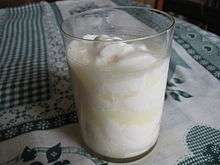Soured milk

Soured milk is a food product produced from the acidification of milk. It is not the same as spoiled milk that has gone bad naturally, commonly also called "soured".[1] Acidification, which gives the milk a tart taste, is achieved either through the addition of an acid, such as lemon juice or vinegar, or through bacterial fermentation. The acid causes milk to coagulate and form a thicker consistency, and inhibits the growth of harmful bacteria and thus improves its shelf life. Soured milk that is produced by bacterial fermentation is more specifically called fermented milk or cultured milk.[2] Soured milk that is produced by the addition of an acid, with or without the addition of microbial organisms, is more specifically called acidified milk.[2] In the United States, acids used to manufacture acidified milk include acetic acid (commonly found in vinegar), adipic acid, citric acid (commonly found in lemon juice), fumaric acid, glucono-delta-lactone, hydrochloric acid, lactic acid, malic acid, phosphoric acid, succinic acid, and tartaric acid.
Soured milk is commonly made at home or is sold and consumed in Europe, especially in Eastern Europe (Belarus, Poland, Russia, Ukraine), all over the countries of former Yugoslavia (Macedonia, Serbia, Montenegro, Bosnia and Herzegovina, Croatia, Slovenia), Bulgaria, Germany, and Scandinavia.
It is also made at home or sold in supermarkets and consumed in the Great Lakes region of Eastern Africa (Kenya, Uganda, Rwanda, Burundi and Tanzania). It is also a traditional food of the Bantu people of Southern Africa.
Since the 1970s, some producers have used chemical acidification in place of biological agents.[3][4][5][6]
In recipes
Sour milk is raw milk that was not used quickly enough. In older recipes that call for sour milk the term refers to milk that was not consumed before it went sour. Prior to refrigeration, this was a common occurrence. Acidified milk, milk that has had an acid such as vinegar or lemon juice added to it, can be substituted for sour milk but it is not the same thing, because acetic acid, citric acid and lactic acid have different flavors and the process of fermentation can produce other flavors. Before going sour, fresh milk is sometimes referred to as sweet milk (because it contains the sugar lactose while in fermented milk the lactose has been converted to lactic acid). Today with modern food safety solutions, it is considered safe to drink sour milk. Buttermilk is a common modern substitute.
References
- ↑ "Dairy-Milk". healthyeating.org.
- 1 2 "TITLE 21--FOOD AND DRUGS: CHAPTER I, PART 131 MILK AND CREAM". Electronic Code of Federal Regulations (e-CFR). 2007-04-01. Retrieved 2007-11-18.
- ↑ Nakamura, Yasunori; Naoyuki Yamamoto; Kumi Sakai; Toshiaki Takano (June 1, 1995). "Antihypertensive Effect of Sour Milk and Peptides Isolated from It That are Inhibitors to Angiotensin I-Converting Enzyme" (PDF). Journal of Dairy Science 78 (6): 1253–7. doi:10.3168/jds.S0022-0302(95)76745-5. PMID 7673515. Retrieved 2007-06-30.
- ↑ Sukhov, SV; Kalamkarova LI; Il'chenko LA; Zhangabylov AK (1986). "Microfloral changes in the small and large intestines of chronic enteritis patients on diet therapy including sour milk products". Voprosy pitaniia (in Russian). Jul-Aug (4): 14–7. PMID 3765530.
- ↑ US patent 3625702, Exler, Heinrich, "PREPARATION OF SOUR MILK DRINKS", published 1971-12-07, issued 1971-12-07, assigned to Heinrich Exler
- ↑ US patent 3978243, Pedersen, Jens Kristian, "Process for preparing gelled sour milk", published 1976-08-31, issued 1976-08-31, assigned to Kobenhavns Pektinfabrik
External links
| Wikimedia Commons has media related to Soured milk. |